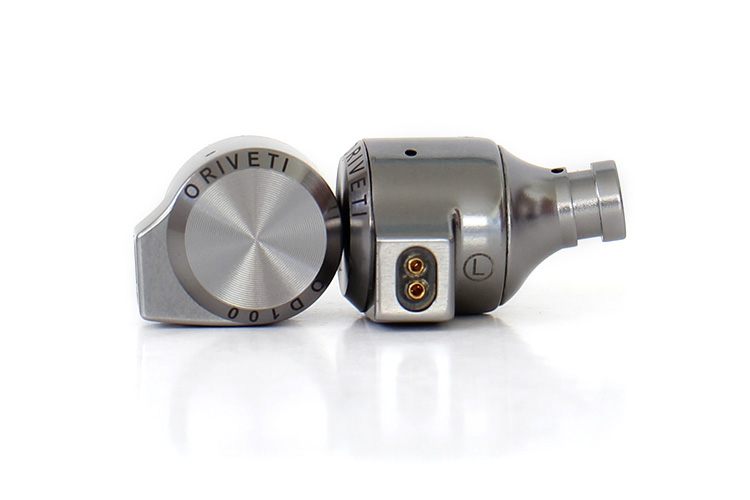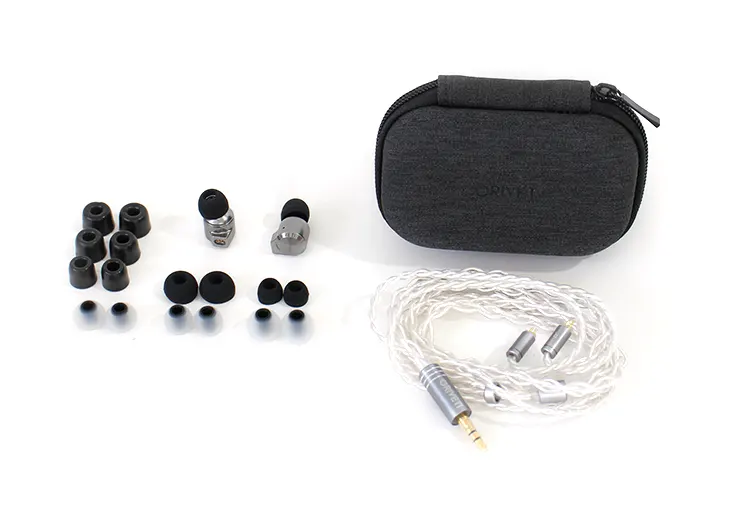In this feature, we review the ORIVETI OD100, which is a new entry-level single DLC 9.2mm dynamic driver universal IEM rated at 16Ω. It is priced at $69.90 SRP.
Disclaimer: This sample was sent to us in exchange for our honest opinion. Headfonics is an independent website with no affiliate links or partnerships. We thank the team at ORIVETI for giving us their support.
Click here to read more about ORIVETI products we have previously featured on Headfonics.
Note, this review follows our current scoring guidelines which you can read up on in more detail here.
We have reviewed ORIVETI before but our last full review from them was back in 2019 with the OH500 and OH300 IEMs and again even further back with the ‘New Primacy’ and BASIC in 2016 and 2017.
You could say it has been a while and the OD100 single dynamic driver IEM may represent something of a comeback for this company. Just a hint, there is a lot more from ORIVETI in the coming months for high-rollers also.
However, for a modest start, the OD100 falls in what I consider an entry-level category but it does not seem to skimp on many of the things that matter and seems to offer lots for your money.
Tech Highlights
The ORIVETI OD100 is marketed as a highly portable and affordable small form factor IEM that does not compromise on sound quality. The OD100 employs what ORIVETI calls a tiny ergonomic IEM design, and I agree that the shell is smaller than average.
At the heart of this tiny shell lies a single 9.2mm dynamic driver that employs a Diamond-like carbon diaphragm backed by a high-density voice coil to give the listener what ORIVETI calls a diamond crystal sound signature.
Apart from that, there is not much else to talk about since this is a simple and basic one-driver IEM so perhaps we can cover some basic specifications.
The 9.2mm driver produces a frequency response of 20Hz to 20kHz, an impedance of 16Ω alongside a 0.08% distortion rating which is a rather low number and was probably measured with a miniscule input. However, the literature does not specify far as to how the distortion level was measured.
Design
The overall shell design seems familiar and is similar to the cylinder-style shell used on some of the TIN Audio IEMs like the T2 and the T4 models but this one has less obvious visual intricacies besides the model identification and company name border etching upfront which was subtly done.
For example, the backplate has a subtle swirl pattern but the rest of the body is just polished metal and the only other note is a couple of holes that most likely function as vents to relieve some of the back pressure from the dynamic driver. The other visual cue you get is the .78mm dual-pin connector connectivity.
The output nozzle does show a small point of interest in that there is a mesh grill but there is an additional phase plug in front of the mesh. I bet that phase plug is one of the tuning implementations.
There are left and right-side etched earbud markings but they are faint and are located on the inside, side by side to the input connectors. I used the angle of the output nozzle as a visual cue which is easier than locating those markings for proper orientation every time you want to use them.
Comfort
The ORIVETI OV100 is very comfortable to wear because of its small size. It is best explained by saying that the only part that touches your physical inner ear is the ear tip and the ear hook.
The cylinder-style shell goes straight in and the angled nozzle uses a proper angle that anchors the tip into the canal but keeps the body from contacting the inner ear somehow.
There is also a good amount of passive noise isolation once you find the right size tips. The average passive reduction can filter out close to 32 dB and this one seems to be in line with similarly rated models in that respect.
Tips
I always use the preinstalled tips on IEMs I get because they are usually the best performers sonically speaking. I did some tip-rolling on the OD100 and the process steered me away from the preinstalled rubber tips and preferred the foam tips.
In the case of the ORIVETI OD100, I also like them with aftermarket comply foam tips similar to the included foam tips. The bass cleans itself up and becomes tighter and better defined. There is an increase in soundstage size and the midrange reveals itself from the induced obscurity produced by the black rubber tips in particular.
These IEMs follow something I have noticed and it is that the tips with an output bore closer to 3.5mm, which I call a narrow bore will produce heavy bass while one with a wider bore will produce more mids so you will have to find a sweet spot to your performance preference. Tip rolling is key here.
The one issue you will notice is that they need a good seal to perform correctly. So, there is a balancing act that you must go through to get the proper performance and seal combination.
Stock Cable
The stock cable is a useful one and surpasses expectations. At this price point, you rarely see a silver multi-strand cable assembly with a quad braid and full metal hardware setup. Just do not expect interchangeable tips or any other fancy features like that.
It is a solid cable assembly with good wire and good hardware. The cable assembly uses an ORIVETI-branded gold plated 3.5mm plug and a matching but unbranded split with a chin adjustment metal piece set with matching male .78mm dual pin connectors at the top ends.
The ear loops are shaped from the cable and encapsulated inside an additional transparent shield. The loops are soft and pliable but are not adjustable.
Packaging & Accessories
Besides the IEMs and the cable assembly, you get nine sets of ear tips in total which is a generous amount if you factor in the asking retail of this IEM. You get three silicon tips, three black rubber tips, and three foam tips. In other words, each type includes three sizes.
Apart from that, I was also surprised to find a decent storage case which again, is almost unheard of at this tier. The case is a semi-hard, zipper-equipped case that can comfortably hold the IEMs along with the cable and even some extra tips.
Literature? I did not find any but if you are like me at this point you are saying who cares about that? What matters is sound quality, comfort, and performance, right?
Sound Impressions
Summary
I did break the ORIVETI OD100 in for approximately 40 hours before judgment and the bass took on more presence plus some of the high frequencies took on better definition. After a certain point, and after 20 hours the changes ceased.
There are two types of headphones and IEMs that I would place in a neutral genre and the two differences lie in that one likes equalization and one does not. The OD100 seems to like sound shaping and equalization so that turns them into an audibly versatile model.
The general OD100 sonic characteristic portrayed is a neutral one with a small bass bump in the midbass area. There is a wide vocal presentation, and the high frequencies are acceptably well-defined but not too forward and not too far extended either.
Bass
The OD100 has a small bump that starts around 60Hz and passes beyond 100Hz and some might be compelled to lower those bands on an EQ to obtain a cleaner bass response because at times and if raised the bass does interfere with the lower mid-band clarity and translation of the source if pushed beyond a certain point.
Bass response is effective down to 25 Hz and below that it takes a gradual dive. The bass is tight and well-controlled for a budget IEM except when using certain tips that push the bass beyond an unnatural timbre.
The bass response is subtly elevated, yes but they can also be tamed and take on additional and a considerably heavier boost. However, with certain tips, they can become bass-heavy but perform with a minimum amount of boominess, distortion, or cone breakup. It all points to a dependency on tip selection.
Midrange
The OD100 midrange response seems forward a couple of decibels and in front of the lower bass response in output especially in the upper midrange region. It is still my favorite part of the overall sound signature along with the bass.
There is a dip in the mids somewhere in the lower region but there is also a small rise above 1kHz. There is also a small spike at the 5kHz mark and thereafter it transitions smoothly into the treble.
The 5k spike gives rise to a sharp upper midrange that can be pushed beyond normal limits and could become noticeable. This spike is the culprit of the perceived forwardness in the midrange area it seems.
Treble
The OD100 treble is on the neutral side and sits perpendicular to the upper midrange output up to a dip that occurs at the top end. The treble response does sound best below the 11kHz mark as the top portion is restrained and produced with a minuscule amount of top-end extension.
The high frequencies offer up a good amount of presence but they lack a final touch of proper representation at the very top. They take an early dip once they go beyond 8 or 9kHz and at times those high notes above that point could come across harshly but not intensely so.
Perhaps further refinement will happen in time as more break-in occurs but I’ve fed them for many hours and not noticed any major differences. But overall, there is much to like because there are no obvious, or obnoxiously exaggerated and fatiguing peaks, just a combating effort to hit those high notes.
Staging and Dynamics
I would say that the only area in staging that the ORIVETI OD100 lacks is height. All the other parameters are there including width and even some frontal projection capabilities, all present within the soundstage.
While depth remains within a credible expansiveness range it seems all sonic energies are focused below the earlobe and above the chin line. But there exists a deep frontal panorama that focuses instruments and projects them in a forward and concentrated manner, while simultaneously widening vocals and in center stage.
Click on page 2 below for our recommended pairings and selected comparisons.







